Maurizio Pierini
Fast Jet Tagging with MLP-Mixers on FPGAs
Mar 05, 2025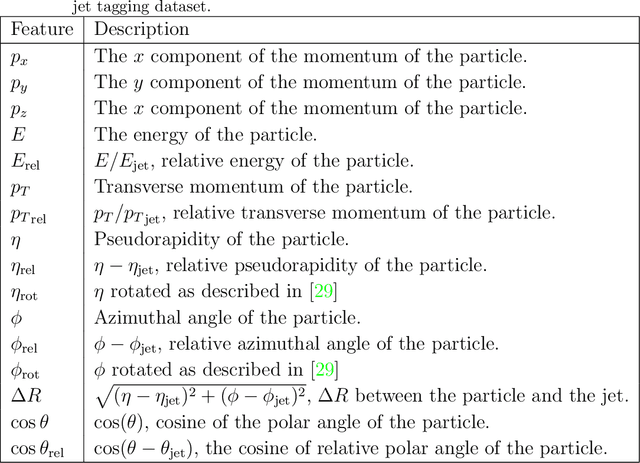
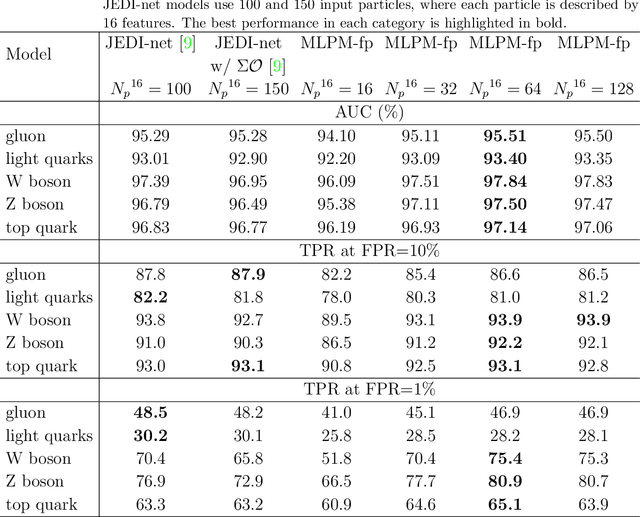
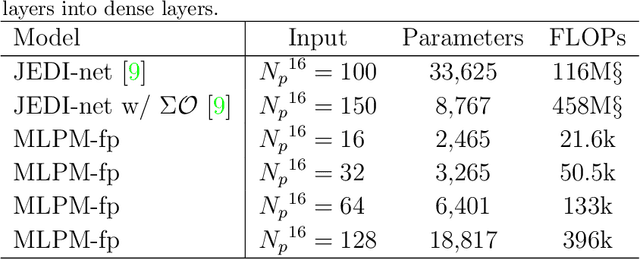
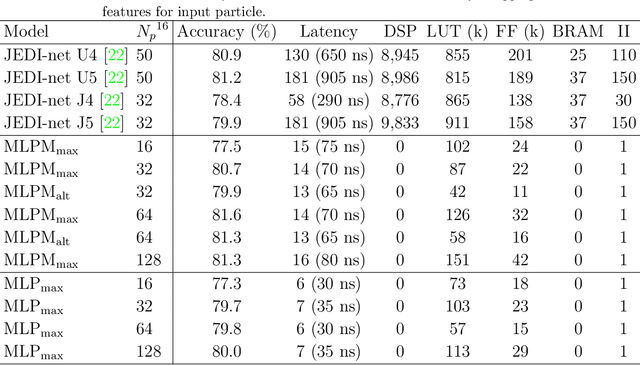
Abstract:We explore the innovative use of MLP-Mixer models for real-time jet tagging and establish their feasibility on resource-constrained hardware like FPGAs. MLP-Mixers excel in processing sequences of jet constituents, achieving state-of-the-art performance on datasets mimicking Large Hadron Collider conditions. By using advanced optimization techniques such as High-Granularity Quantization and Distributed Arithmetic, we achieve unprecedented efficiency. These models match or surpass the accuracy of previous architectures, reduce hardware resource usage by up to 97%, double the throughput, and half the latency. Additionally, non-permutation-invariant architectures enable smart feature prioritization and efficient FPGA deployment, setting a new benchmark for machine learning in real-time data processing at particle colliders.
tn4ml: Tensor Network Training and Customization for Machine Learning
Feb 18, 2025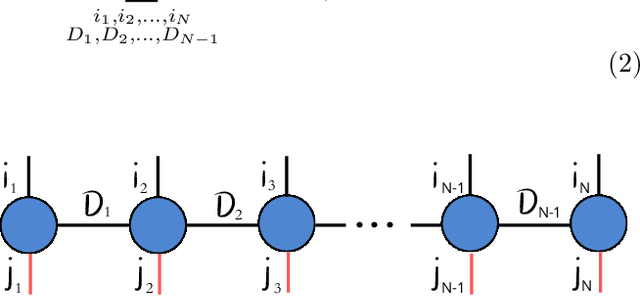



Abstract:Tensor Networks have emerged as a prominent alternative to neural networks for addressing Machine Learning challenges in foundational sciences, paving the way for their applications to real-life problems. This paper introduces tn4ml, a novel library designed to seamlessly integrate Tensor Networks into optimization pipelines for Machine Learning tasks. Inspired by existing Machine Learning frameworks, the library offers a user-friendly structure with modules for data embedding, objective function definition, and model training using diverse optimization strategies. We demonstrate its versatility through two examples: supervised learning on tabular data and unsupervised learning on an image dataset. Additionally, we analyze how customizing the parts of the Machine Learning pipeline for Tensor Networks influences performance metrics.
Sets are all you need: Ultrafast jet classification on FPGAs for HL-LHC
Feb 02, 2024
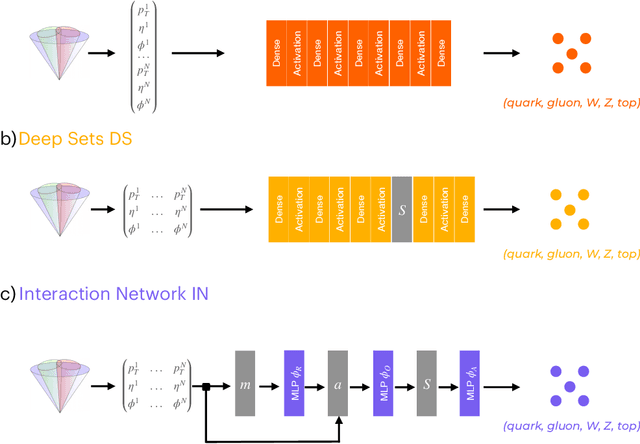
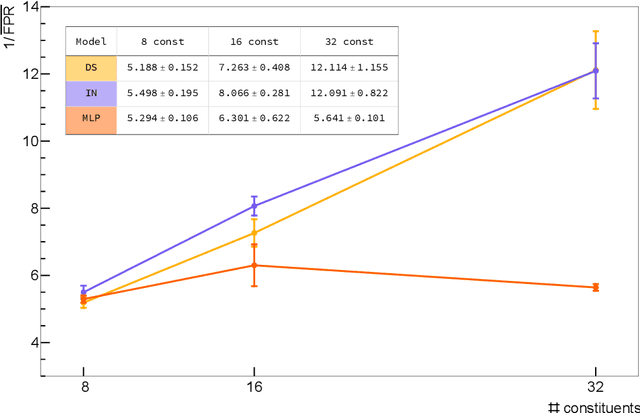

Abstract:We study various machine learning based algorithms for performing accurate jet flavor classification on field-programmable gate arrays and demonstrate how latency and resource consumption scale with the input size and choice of algorithm. These architectures provide an initial design for models that could be used for tagging at the CERN LHC during its high-luminosity phase. The high-luminosity upgrade will lead to a five-fold increase in its instantaneous luminosity for proton-proton collisions and, in turn, higher data volume and complexity, such as the availability of jet constituents. Through quantization-aware training and efficient hardware implementations, we show that O(100) ns inference of complex architectures such as deep sets and interaction networks is feasible at a low computational resource cost.
Knowledge Distillation for Anomaly Detection
Oct 09, 2023


Abstract:Unsupervised deep learning techniques are widely used to identify anomalous behaviour. The performance of such methods is a product of the amount of training data and the model size. However, the size is often a limiting factor for the deployment on resource-constrained devices. We present a novel procedure based on knowledge distillation for compressing an unsupervised anomaly detection model into a supervised deployable one and we suggest a set of techniques to improve the detection sensitivity. Compressed models perform comparably to their larger counterparts while significantly reducing the size and memory footprint.
Triggering Dark Showers with Conditional Dual Auto-Encoders
Jun 22, 2023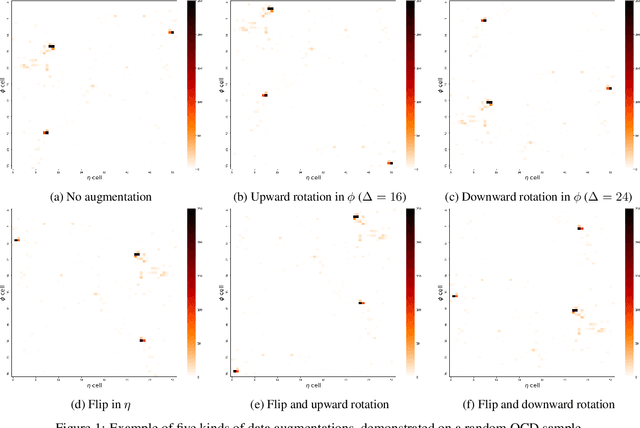
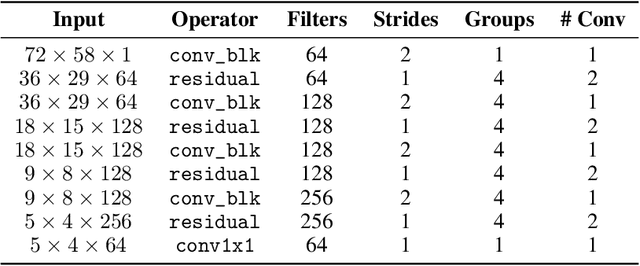
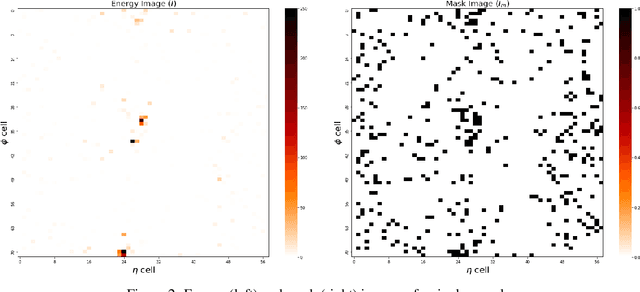
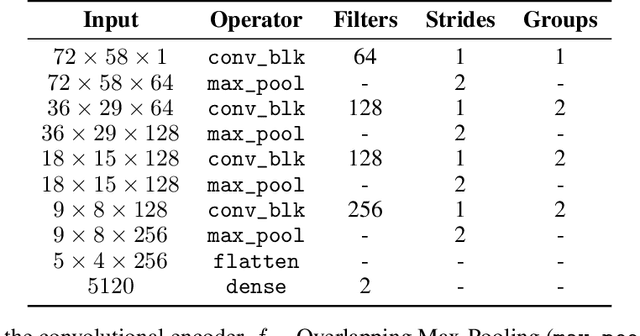
Abstract:Auto-encoders (AEs) have the potential to be effective and generic tools for new physics searches at colliders, requiring little to no model-dependent assumptions. New hypothetical physics signals can be considered anomalies that deviate from the well-known background processes generally expected to describe the whole dataset. We present a search formulated as an anomaly detection (AD) problem, using an AE to define a criterion to decide about the physics nature of an event. In this work, we perform an AD search for manifestations of a dark version of strong force using raw detector images, which are large and very sparse, without leveraging any physics-based pre-processing or assumption on the signals. We propose a dual-encoder design which can learn a compact latent space through conditioning. In the context of multiple AD metrics, we present a clear improvement over competitive baselines and prior approaches. It is the first time that an AE is shown to exhibit excellent discrimination against multiple dark shower models, illustrating the suitability of this method as a performant, model-independent algorithm to deploy, e.g., in the trigger stage of LHC experiments such as ATLAS and CMS.
Differentiable Earth Mover's Distance for Data Compression at the High-Luminosity LHC
Jun 07, 2023Abstract:The Earth mover's distance (EMD) is a useful metric for image recognition and classification, but its usual implementations are not differentiable or too slow to be used as a loss function for training other algorithms via gradient descent. In this paper, we train a convolutional neural network (CNN) to learn a differentiable, fast approximation of the EMD and demonstrate that it can be used as a substitute for computing-intensive EMD implementations. We apply this differentiable approximation in the training of an autoencoder-inspired neural network (encoder NN) for data compression at the high-luminosity LHC at CERN. The goal of this encoder NN is to compress the data while preserving the information related to the distribution of energy deposits in particle detectors. We demonstrate that the performance of our encoder NN trained using the differentiable EMD CNN surpasses that of training with loss functions based on mean squared error.
Goodness of fit by Neyman-Pearson testing
May 23, 2023



Abstract:The Neyman-Pearson strategy for hypothesis testing can be employed for goodness of fit if the alternative hypothesis $\rm H_1$ is generic enough not to introduce a significant bias while at the same time avoiding overfitting. A practical implementation of this idea (dubbed NPLM) has been developed in the context of high energy physics, targeting the detection in collider data of new physical effects not foreseen by the Standard Model. In this paper we initiate a comparison of this methodology with other approaches to goodness of fit, and in particular with classifier-based strategies that share strong similarities with NPLM. NPLM emerges from our comparison as more sensitive to small departures of the data from the expected distribution and not biased towards detecting specific types of anomalies while being blind to others. These features make it more suited for agnostic searches for new physics at collider experiments. Its deployment in other contexts should be investigated.
Symbolic Regression on FPGAs for Fast Machine Learning Inference
May 06, 2023



Abstract:The high-energy physics community is investigating the feasibility of deploying machine-learning-based solutions on Field-Programmable Gate Arrays (FPGAs) to improve physics sensitivity while meeting data processing latency limitations. In this contribution, we introduce a novel end-to-end procedure that utilizes a machine learning technique called symbolic regression (SR). It searches equation space to discover algebraic relations approximating a dataset. We use PySR (software for uncovering these expressions based on evolutionary algorithm) and extend the functionality of hls4ml (a package for machine learning inference in FPGAs) to support PySR-generated expressions for resource-constrained production environments. Deep learning models often optimise the top metric by pinning the network size because vast hyperparameter space prevents extensive neural architecture search. Conversely, SR selects a set of models on the Pareto front, which allows for optimising the performance-resource tradeoff directly. By embedding symbolic forms, our implementation can dramatically reduce the computational resources needed to perform critical tasks. We validate our procedure on a physics benchmark: multiclass classification of jets produced in simulated proton-proton collisions at the CERN Large Hadron Collider, and show that we approximate a 3-layer neural network with an inference model that has as low as 5 ns execution time (a reduction by a factor of 13) and over 90% approximation accuracy.
Progress towards an improved particle flow algorithm at CMS with machine learning
Mar 30, 2023
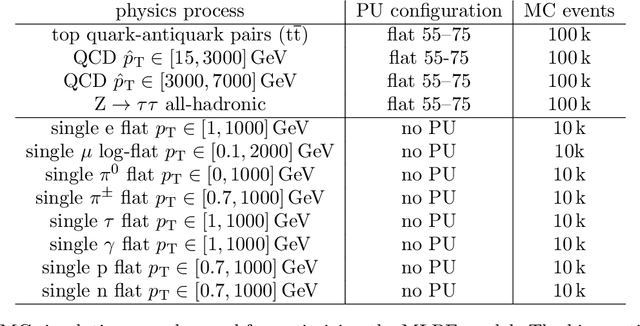
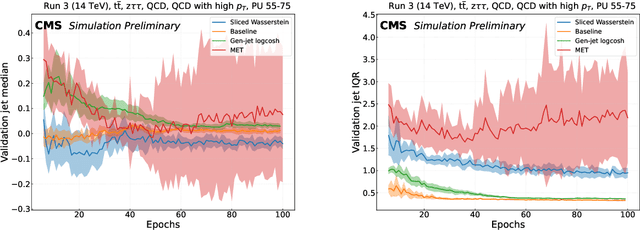
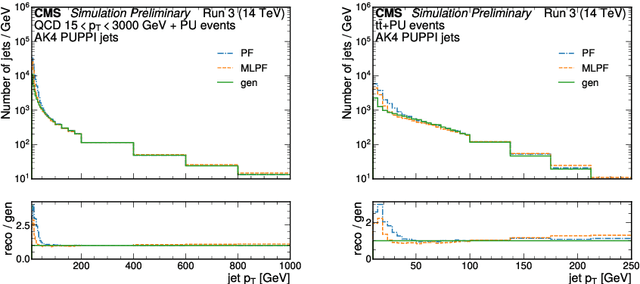
Abstract:The particle-flow (PF) algorithm, which infers particles based on tracks and calorimeter clusters, is of central importance to event reconstruction in the CMS experiment at the CERN LHC, and has been a focus of development in light of planned Phase-2 running conditions with an increased pileup and detector granularity. In recent years, the machine learned particle-flow (MLPF) algorithm, a graph neural network that performs PF reconstruction, has been explored in CMS, with the possible advantages of directly optimizing for the physical quantities of interest, being highly reconfigurable to new conditions, and being a natural fit for deployment to heterogeneous accelerators. We discuss progress in CMS towards an improved implementation of the MLPF reconstruction, now optimized using generator/simulation-level particle information as the target for the first time. This paves the way to potentially improving the detector response in terms of physical quantities of interest. We describe the simulation-based training target, progress and studies on event-based loss terms, details on the model hyperparameter tuning, as well as physics validation with respect to the current PF algorithm in terms of high-level physical quantities such as the jet and missing transverse momentum resolutions. We find that the MLPF algorithm, trained on a generator/simulator level particle information for the first time, results in broadly compatible particle and jet reconstruction performance with the baseline PF, setting the stage for improving the physics performance by additional training statistics and model tuning.
* 7 pages, 4 Figures, 1 Table
Towards Optimal Compression: Joint Pruning and Quantization
Feb 15, 2023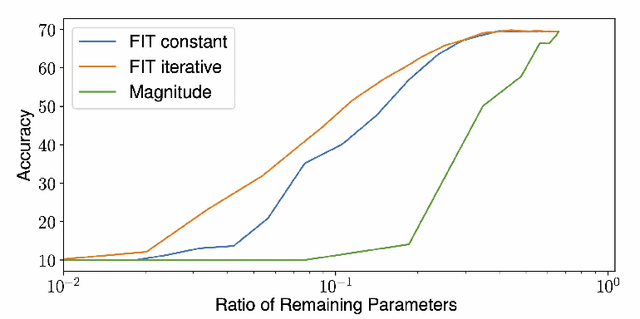


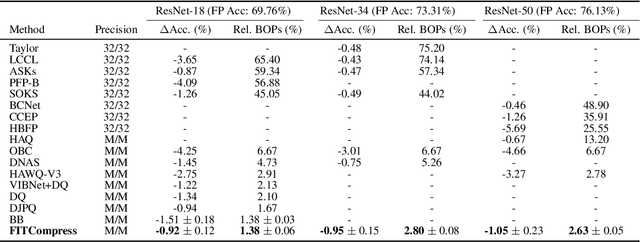
Abstract:Compression of deep neural networks has become a necessary stage for optimizing model inference on resource-constrained hardware. This paper presents FITCompress, a method for unifying layer-wise mixed precision quantization and pruning under a single heuristic, as an alternative to neural architecture search and Bayesian-based techniques. FITCompress combines the Fisher Information Metric, and path planning through compression space, to pick optimal configurations given size and operation constraints with single-shot fine-tuning. Experiments on ImageNet validate the method and show that our approach yields a better trade-off between accuracy and efficiency when compared to the baselines. Besides computer vision benchmarks, we experiment with the BERT model on a language understanding task, paving the way towards its optimal compression.
 Add to Chrome
Add to Chrome Add to Firefox
Add to Firefox Add to Edge
Add to Edge